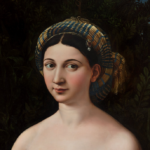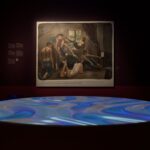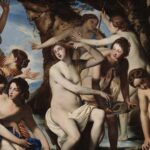La Fornarina is an artwork by Rafaello Sanzio, now preserved in Palazzo Barberini in Rome .
The artwork is among the best known of the “master of beauty” as Raffaello is called.
Who was the Fornarina?
It is presumably Margherita Luti, daughter of a Roman baker and for this reason known to history with the nickname of Fornarina.
It is believed that Margherita, of whose biography little is known, was Raphael‘s mistress, if not even wife, at least in the last years of the artist’s life, as suggested by some.
Indeed, one of the few certain facts about the young woman’s life is that in the 1620s she converted to monastic life by entering the monastery of Sant’ Apollonia in Trastevere.
Just a few months after Raphael’s death.
Hence the hypothesis of a secret marriage and the girl’s decision to enter the monastery upon her husband’s death.
She was probably also a model for other artworks by Raphael such as the Veiled, which denotes a certain similarity.

La Fornarina by Raffaello
The Fornarina is portrayed nude, suggesting that the painting was intended for a private collection.
Moreover, nothing is known about the actual commissioner of the canvas, so much so that it was thought Rafaellopainted it for himself.
The woman is portrayed bare-breasted, protected only by a veil she holds to her chest with her right hand and a red cloak covering her legs. The figure is in three-quarter view, toward the left, while his eyes looking to the right overtake the viewer’s gaze.
She wears a bracelet, on which appears the inscription “Raphael Urbinas,” the artist’s signature and also a symbol of a pledge of love.
The style
From a style point of view, La Fornarina was made in two shots.
A myrtle bush – a plant sacred to Venus – can be seen in the dark background, but initially there should have been a Leonardo-inspired landscape, like that of Mona Vanna.

The girl’s image stands out in contrast to what lies behind her, thanks to the light, which, from the left, highlights her.
The pose of the right hand on the breast recalls the gesture proper to the Veiled, another famous work by Rafaello, however the design of the ear differs from the latter.
Between the Fornarina and Venus, besides the myrtle bush, there are other connections: the former in fact follows the model of the “demure Venus” in classical statuary.














